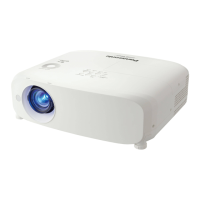
Do you have a question about the Panasonic PT-VX610 and is the answer not in the manual?
Essential safety and initial setup information before operating the projector.
Critical warnings regarding electrical shock, fire hazards, and safe product operation.
Advice on compliance, environmental conditions, and proper handling of the projector.
Critical safety instructions for power connection, cord usage, and installation environment.
Warnings about exhaust ports, lens exposure, projector modification, and liquid contact.
Critical safety instructions and warnings for lamp unit replacement.
Cautions for lamp units, battery storage, and air filter maintenance.
Focuses on flexible setup with optical zoom and lens shift functions.
A step-by-step guide for setting up the projector for the first time.
Essential precautions before using the projector, covering transport and installation.
Guidelines for safely transporting, installing, and operating within environmental limits.
Instructions for proper projector placement and airflow management.
Information on security measures, monitoring software, and product disposal.
Tips for optimal picture quality, lens care, and luminous lamp characteristics.
Lists provided accessories and important handling and storage guidelines.
Details on operating instructions, compatible models, and software on the CD-ROM.
Lists optional items like ceiling mount brackets and replacement parts.
Identifies and explains the buttons and functions of the remote control.
Details projector parts, ports, and critical safety warnings for the exhaust port.
Explains the projector's control panel buttons and status indicators.
Details pin configurations for computer and HDMI input terminals.
Instructions for battery handling and setting up remote control for multiple projectors.
Step-by-step guide to attach the lens cap with its string for protection.
Describes installation orientations and the function of the built-in angle sensor.
Details optional brackets, installation safety, and screen size planning.
Illustrates projection range and correction angles for keystone and curved correction.
Provides formulas to calculate projection distance based on screen size.
Important notes before connecting and pin configurations for computer/HDMI terminals.
Illustrates how to connect AV devices like Blu-ray players and video decks.
Shows diagrams for connecting computers to the projector.
Instructions for connecting the power cord and understanding the power indicator.
Step-by-step guide to power on the projector and begin projection.
How to navigate and complete initial setup for language and projector configurations.
Adjusting projection method, screen format, and standby mode during initial setup.
Guides on adjusting focus, zoom, and vertical shift for optimal image display.
Procedure for safely powering down the projector and entering standby mode.
Information and warnings related to direct power off functionality for safety.
How to choose the active input signal and switch inputs using remote/panel.
Guidance on adjusting image state, position, focus, and zoom.
Steps for adjusting projector angle, feet, zoom, and focus.
Explains vertical optical axis shift for adjusting projection position.
How to mute audio/video and adjust volume levels using the remote.
Using freeze, auto setup for alignment, and screen adjustment for distortion.
Using digital zoom and assigning functions to the FUNCTION button.
Using the timer and setting remote IDs for multi-projector control.
Step-by-step guide to access and navigate the projector's menu system.
Procedures to restore menu settings to their original factory defaults.
Lists the primary categories and how to navigate them.
Settings for image quality adjustments including mode, contrast, and brightness.
Settings for image position, keystone, and screen adjustments.
Options for selecting language and configuring display output settings.
Configuration settings for projector operation, status, and startup.
Settings for password protection, menu lock, and network configuration.
How to select picture modes and adjust contrast and brightness.
Adjusting color saturation and tint for optimal image appearance.
Adjusting sharpness for image clarity and color temperature for tint correction.
Adjusting gamma, iris, daylight view, and cinema reality for image enhancement.
Settings for noise reduction, TV system, and RGB signal formats.
Selecting the appropriate RGB system based on input signal resolution and frequency.
Enabling automatic keystone correction and correcting screen distortions.
Detailed steps for adjusting keystone and corner corrections.
Procedures for correcting curved image distortion and linearity.
Adjusting the vertical and horizontal position of the projected image.
Adjusting dot clock and clock phase to reduce noise and improve image flicker.
Adjusting over scan for cropping and selecting image aspect ratios.
Synchronizing the displayed image to vertical scanning frequency for stable display.
How to change the on-screen display language to various supported languages.
Correcting color differences when using multiple projectors simultaneously.
Detailed steps to adjust red, green, and blue colors for precise color matching.
Detailed steps to adjust colors and register color corrections.
Configuring elements like input guides and OSD position.
Setting input guide display and adjusting OSD position and size.
Settings for warning messages, HDMI signal level, and closed captions.
Selecting caption mode, screen format, position, and startup logo.
Configuring auto setup, signal search, and background color settings.
Setting and operating the presentation timer.
Setting timer modes and operating the presentation timer.
Alternative menu access for functions operated by remote control buttons.
Operating the freeze, AV mute, and digital zoom functions.
Displaying status, selecting computer input, and setting projector ID.
Configuring startup, projection method, and lamp power settings.
Optimizing power saving features for eco-friendly operation.
Setting emulation for compatibility and configuring standby power consumption.
Detailed settings for audio output, volume, and mute status.
Configuring standby audio, input selection, and displaying test patterns.
Checking air filter usage, setting timers, and resetting the filter counter.
Enabling DC output and restoring all settings to factory defaults.
Setting password entry and changing the security password.
Configuring security messages, menu operations, and menu lock passwords.
Enabling or disabling button operations on the control panel and remote control.
Setting up wired LAN, DHCP, IP address, and projector name.
Configuring network control methods and checking network status.
Checking network status and initializing network settings.
Steps to connect via wired LAN and configure projector network settings.
Performing detailed network settings and configuring the computer.
Compatible browsers and steps to access the projector via web browser.
Details on access rights and descriptions of web interface items.
Overview of the status and control pages within the web interface.
How to view error messages and network status via the web interface.
Interfaces for basic and detailed projector controls via web.
Interface for configuring network settings such as IP address and subnet mask.
Settings for eco management functions and network connectivity tests.
Configuring email notifications for projector status and errors.
Setting up authentication methods for sending emails.
An example of an email notification sent when an error occurs in the projector.
Configuring the port number used for command control via LAN.
Interface for changing administrator and user account passwords.
Managing user account passwords for the web control interface.
The main operation interface and tools pages for controlling the projector via web.
Viewing projector information and accessing help resources via web control.
Explains lamp indicator lights and actions for lamp-related issues.
Explains temperature indicator lights and actions for overheating or filter issues.
Safety checks and procedures for cleaning the outer case and lens.
Information on maintaining the projector's air filter unit, including checking and cleaning.
Step-by-step guide to remove, wash, and dry the air filter unit.
Instructions for reattaching the air filter unit and resetting its counter.
Information on replacing the consumable lamp unit, including timing and notes.
Critical safety warnings and detailed steps for replacing the lamp unit.
Detailed steps for removing and installing the lamp unit and cover.
Instructions for replacing the air filter unit and resetting its counter.
A guide to common issues and checks for troubleshooting projector problems.
Details on PJLink protocol support and available control commands via LAN.
Explanation of the data format for sending and receiving commands via LAN.
Information on error responses and web control without administrator password.
Diagram of network flow and serial port connection details.
Pinout details, communication settings, and command format for serial port.
Lists commands usable for controlling the projector from a computer via serial or LAN.
Instructions on how to initialize or reset the menu lock password.
Table specifying compatible video, RGB, and HDMI signals with projector inputs.
Additional notes regarding signal compatibility, resolution conversion, and display issues.
Technical specifications for power, consumption, LCD panel, lens, and lamp details.
Specifications for contrast ratio, image aspect ratio, and speaker.
Physical dimensions, noise level, operating environment, and terminal specifications.
Summary of compatible signal types for video, RGB, and HDMI inputs.
Diagrams showing the external dimensions of the projector in millimeters and inches.
Safety guidelines and screw hole specifications for ceiling mounting.
Information on product disposal and compliance with restricted substances marking.
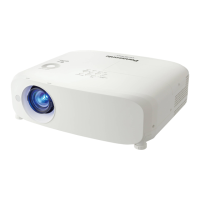


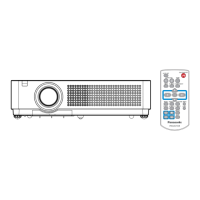


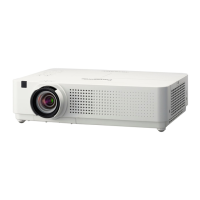
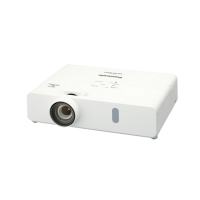

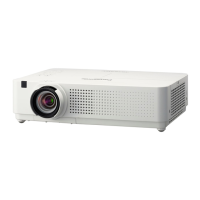
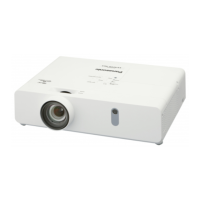
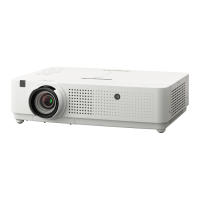
